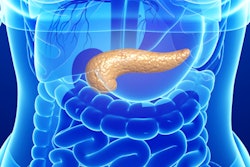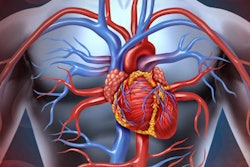
SAN FRANCISCO - Whether or not CT perfusion (CTP) is justified beyond the brain is a tough call -- so tough, in fact, that organizers of the International Society for Computed Tomography (ISCT) 2016 Symposium decided to debate the question. CTP can be a powerful tool, they said, but its utility is less certain than its generous radiation dose.
Thus, the question facing ISCT 2016 delegates was whether the benefits of CTP (beyond well-established brain perfusion) were worth the dose. Arguing for a broad approach to CTP was Dr. Patrick Rogalla, professor of radiology at the University of Toronto. Arguing that the benefits aren't yet proved was Dr. William Shuman, professor of radiology at the University of Washington.
Shuman: Too difficult, unproved
Shuman offered evidence that although CPT may not be exactly dead, it's not ready for prime time. CTP is only being considered due to recent advances in detector technology that have made it potentially viable by shortening scan times, integrating two detector arrays, reducing tube voltage, and more, he said.
 Dr. William Shuman from the University of Washington.
Dr. William Shuman from the University of Washington.But a recent 2015 review of CTP literature was skeptical of its value, Shuman said.
"Although the dose from CT perfusion is typically less than about 30 mSv, local doses in the examined body region are rather high and may result in harmful radiation damages when the examination is repeated several times or combined with other high-dose angiographic or interventional procedures," Shuman quoted from the review by Brix et al writing in the European Journal of Radiology. The article estimated brain perfusion doses of 100-190 mGy, heart doses of 15-50 mGy, and cancer imaging doses of 80-270 mGy.
"These are very substantial doses, particularly when you combine them over time, or there are other procedures involved requiring radiation," Shuman said.
Another 2015 article by Brix et al said that although preliminary studies have yielded promising results for perfusion imaging, "several methodological problems need to be resolved and larger patient studies need to be performed before [dynamic contrast-enhanced CT perfusion] can be implemented in routine practice to noninvasively assess vascular support of myocardium or cancer."
"This author said you have to do three things, and you have to be very careful doing research with perfusion," Shuman said. The investigator must know the dose, optimize scan parameters to minimize dose, and justify the exam: "Is the intended perfusion CT exam likely to provide new information on tissue microcirculation that will affect diagnosis and therapy management of the patient, and is the radiation risk of the procedure less than the radiation risk of missing that information?"
It's a tough question to answer, but it must be done before every CTP test, he said.
A 2014 paper on CTP decried the paucity of large multicenter trials and the lack of validated software for measuring the results. Moreover, most software is locally authored at the institution where it's being used, creating a lack of standardization, Shuman said. A 2016 paper on CTP for myocardial perfusion noted that optimal scan parameters and reconstruction methods, image processing, and standardization of procedures remain unsolved.
"All put together, what these very recent publications are saying is that the radiation doses are still high, and that it's not ready for prime time," Shuman said.
Rogalla: CTP evidence is compelling
For his part, Rogalla said CTP presents two essential questions: Where is the clinical value of the exam, and is it great enough to justify its use?
 Dr. Patrick Rogalla from the University of Toronto.
Dr. Patrick Rogalla from the University of Toronto.Based on his reading of the literature, "I believe in CT perfusion and I think it does a great job," Rogalla said. For example, in 2013 Ohno et al published a paper in the American Journal of Roentgenology comparing CTP with FDG-PET for the management of solitary pulmonary nodules. Granted, he said, FDG-PET is usually tasked with finding remote metastases, not a local finding.
"But the interesting outcome of that study is that area CT is actually better than PET/CT," he said. The AJR study revealed that CTP on a 320-detector-row scanner found 83.3% of the pulmonary nodules, compared with 60.4% for PET/CT (p < 0.05).
Similarly, Fraioli et al used whole-tumor CTP to investigate patients with advanced lung adenocarcinomas treated with conventional and antiangiogenic chemotherapy (Radiology, 2011). CTP measured clearly decreased blood volume, blood flow, and permeability of responders, as opposed to an increase in these parameters for nonresponders.
"The key thing here is that it did not correlate with [the Response Evaluation Criteria in Solid Tumors (RECIST)], which is the current standard in oncology to assess response to those drugs," Rogalla said.
Moreover, a 2013 study by Yuan et al (European Radiology) sought to differentiate benign from malignant nodules in patients with non-small cell lung cancer treated with two targeted therapies. Again, they found that blood flow correlated with effective response to therapy and showed a trend toward longer progression-free survival.
"Now, you need to know, those drugs are extremely expensive. ... One week of unnecessary treatment outweighs by far the cost of a single CT study," Rogalla said. "And it's critically important for patients to stay with this drug, because if it doesn't work, and you miss the timeline, you miss the point where you could potentially cure the patients with another drug."
Even for answering the simple question of whether a nodule is malignant or benign, studies have shown that CTP is a valuable biomarker, he said. Granted it's hard to do, and people who don't know how to perform CTP should stay away from both the procedure and the untested software that supports it. But there is simply no replacing CTP for determining benignity versus malignancy and assessing treatment response, Rogalla said.
CTP studies in Radiology found that doses ranged from 7.3 mSv to 8.7 mSv using iterative reconstruction. A just-published Chinese study in Abdominal Radiology performed low-dose whole-organ CPT of the pancreas at between 3.60 mSv and 4.88 mSv. The researchers concluded that low-dose CTP can be performed at low doses and provides "the best phase for the individual pancreas scan," he said.
"The usual paradigm in CT is that radiation comes from dose, and the critical question is do we need that information," Rogalla said. "And I think the answer is yes." With blood flow being the single most important marker in oncology, a 50% higher dose to get that information is clinically justified, he said.
Not so fast
In his rebuttal, Shuman said that while CTP may increase the dose by only 50%, "it is also true that CT perfusion delivers that dose to a much smaller volume of tissue," he said. "That's where the danger comes in."
The famous picture of the horrifically overexposed infant published in newspapers across the U.S. a few years back was actually a CT tumor perfusion study, he added.
"It's the deterministic effects that we have to worry about, and those are the reasons why I think we're a long way from prime time" and that it will be a long time before CTP reaches routine practice, Shuman said.
Rogalla countered that both of Shuman's main studies were published in Germany, a country that is "hysterical about radiation dose," and they should not be relied on for evenhanded conclusions on the subject.
"Maybe it's your loved one who has cancer, advanced-stage, with a life expectancy of months or years," Rogalla said. And imagine there is a tool that might answer the question as to whether the expensive drug that could potentially allow the patient to live will work or not.
"But you tell him, I just came from ISCT, and the panel decided it's not worth it," he said. "No, I would not advise this test for the general public, but if you turn this test to those who actually need it, I think it's well-justified."
A poll of session attendees after the debate showed that CTP won the day, marginally, at 59% for it versus 41% against it.




















